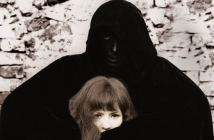
The Canterbury Tales (1972)
Cast: Hugh Griffith, Laura Betti, Ninetto Davoli
Director: Pier Paolo Pasolini
Country: Italy | France
Genre: Drama | Comedy
Official Site: Here
Editor’s Notes: The following review is part of our coverage for TIFF’s Pier Paolo Pasolini: The Poet of Contamination which runs from March 8th to April 12th at TIFF Bell Lightbox. For more information on upcoming TIFF film series visit http://tiff.net and follow TIFF on Twitter at @TIFF_NET.
Pier Paolo Pasolini’s take on Geoffrey Chaucer’s The Canterbury Tales is an interesting one if only a superficial one. Pasolini does not concern himself with much more than the raunchy stories from the Chaucer classic, and even then he only seeks to show us as many naughty bits as possible without retaining much clarity of storytelling or any of the wit or satire from the epic poem. The film is the second of Pasolini’s ‘Medieval Trilogy’ or ‘Trilogy of Life’, after his adaptation of Boccaccio’s The Decameron and before The Arabian Nights. It’s fitting that this follow The Decameron since that book is said to have been a great influence on Chaucer in his writing of The Canterbury Tales.
Pasolini does not concern himself with much more than the raunchy stories from the Chaucer classic, and even then he only seeks to show us as many naughty bits as possible without retaining much clarity of storytelling or any of the wit or satire from the epic poem.
The film begins in a town where pilgrims are about to set out for Canterbury. A man announces that to pass the time, each will tell a tale. The film then abruptly cuts to the first story, about a lord (Hugh Griffith, who played the neighboring squire in Tony Richardson’s brilliant 1963 film Tom Jones) who marries May (Josephine Chaplin, daughter of Charles), a woman many years his junior and is struck blind by a mischievous god or elf king or something (he and his queen stroll about nude in the lord’s private garden). May is unfaithful to the lord and takes up with a man more her age.
That story is the longest and most coherent of the eight represented stories. Others include the devil (played by Franco Citti, who played Michael Corleone’s Sicilian bodyguard in The Godfather and The Godfather part III) following around a church informant who rats out people engaging in homosexual acts, one is rich enough to pay his way out of excommunication and another is burned alive (the British custom that yielded their slang for logs and cigarettes, so it’s probably about time to stop using that pejorative). Another about a student who tricks his benefactor so he can sleep with his wife, then still another about a woman who has been through four or five husbands until her last one, Tom Baker (the 4th Doctor on Doctor Who before he took the role. I admit this one was disturbing because he does full frontal) ends up killing her accidentally. And also the Miller’s Tale, where two students try to prevent being cheated by the flour miller and end up sleeping with the Miller’s wife and daughter.
The last story, which I believe to be The Friar’s Tale, provides an odd depiction of hell that is an eye-popping example of staging and grotesque humor. This humor involves discovering where corrupt friars go for eternity (a demon’s anus) and a lot of other things that should probably go unmentioned. And there to ‘hold it all together’ is Pasolini himself as Chaucer, intermittently showing up to have an idea enter his head and begin writing the next section.
To that end, there is some stunning set, production and costume design. The aura is exceedingly well crafted and really puts the viewer in that time as best as it can be approximated.
The problem is that everything is just blended together without any kind of introduction or cutaways to the road to see the storyteller. It’s just a pastiche of sex scenes and ‘comedy’ that doesn’t make any real narrative sense. There’s not structure to the piece at all and that’s what ultimately makes it suffer. What it ends up being is the precursor to the late 70s/early 80s skin flicks based on racy novels that strips out any of the wit, satire or romance from source material leaving us with good period detail and lots of nudity.
To that end, there is some stunning set, production and costume design. The aura is exceedingly well crafted and really puts the viewer in that time as best as it can be approximated. Pasolini’s eye for locale (the film was shot in England) and general authenticity is brilliant and is really the best part of the film.
Within these glorious surroundings, Pasolini gets some of the broadest and least interesting performances out of his actors. While they are obviously going for laughs, the performances are so broad that they hit their target and lots of stuff around it too, diminishing the impact completely. Add to this the poor dubbing of the non-English speaking actors and the unfocused screenplay and the film becomes kind of a mess.
I was also dismayed by how Pasolini chose to shoot the film. The colors are muted and bland, and while I can see that he was still going for authenticity with the stereotypically grey English sky and surroundings, it all looks like it was shot on video instead of film. It has a cheap quality to it that pulls a viewer out of the film because it looks like they could have shot it themselves.
With all of that working against it, the film remains watchable. It never becomes boring because you spend the time wondering what outrageous thing Pasolini will show you next. It’s not involving, just interesting. It’s a shame that he couldn’t have made it more structured and give some framing devices to alert people that a new story was coming, more than just his Chaucer sitting in a chair waiting to be struck with inspiration (which only happens two or three times). If anything, this film continues his descent into more fetishistic filmmaking that would reach its conclusion two films later with Salo: or 120 Days of Sodom (1975), which proved to be his final film.
The great tragedy of this film is that it is made by a man who could have brought out the wit and subtlety of Chaucer’s work but chose to focus on the raunchy sex parts that high schoolers underline when they study the work. All of it seems like an adolescent’s idea of what a film should be, right down to copious amounts of people farting (seriously, I think more people fart in this film than in Blazing Saddles). It’s all so immature and that makes it regrettable, especially since this filmmaker is responsible for such masterworks as Mamma Roma (1962) and The Gospel According to St. Matthew (1966), two high-minded films that have a sense of humor where it’s needed (at least Mamma Roma does) and can evoke emotional responses. As he aged as an artist, it seems he became more concerned with shocking people than telling a good story, and that is why this film doesn’t live up to its or his potential.
[notification type=”star”]65/100 ~ OKAY. The problem with The Canterbury Tales is that everything is just blended together without any kind of introduction or cutaways to the road to see the storyteller. It’s just a pastiche of sex scenes and ‘comedy’ that doesn’t make any real narrative sense. [/notification]



